As an Amazon Associate KitchenwareSets.com earns from qualifying purchases.
Green Rustic Kitchen Ideas To Create A Natural Retreat
Does your kitchen feel more like a sterile lab than the heart of your home? It’s a common problem in a world of all-white, uninspired designs. A green rustic kitchen is an interior design style that blends earthy green palettes with natural, unrefined materials like wood and stone to create a warm, cozy atmosphere.
You’re searching for a space that feels personal, calming, and connected to nature. This guide delivers more than just pictures; it provides a blueprint for creating that retreat. A green rustic kitchen is an interior design style that combines earthy green color palettes with natural, unrefined materials like wood and stone to create a cozy, inviting atmosphere that feels both timeless and personal. You’ll discover nine beautiful, achievable ideas to transform your kitchen into a natural sanctuary.
Why Does My Kitchen Feel Cold and Uninspired?
Many modern kitchens, with their sleek surfaces and neutral palettes, can end up feeling cold, sterile, and disconnected from the rest of the home. If you find your kitchen lacks personality and warmth, you’re not alone. The universal desire is for a kitchen that feels like a sanctuary—a cozy, welcoming space that serves as the heart of the home. This is where the green rustic kitchen concept shines.
It’s the perfect solution, acting as a natural retreat within your own walls. This design style masterfully blends the calming, earthy tones of a green color palette with the warm, natural texture of rustic elements like wood accents. By combining these, you move away from a cold, uninspired room and create a space that feels grounded, personal, and deeply connected to the outdoors. We’ll show you how to blend these timeless kitchen design principles to craft your perfect cozy kitchen style.
9 Green Rustic Kitchen Ideas for a Cozy, Natural Retreat
Ready to move from dreaming to doing? This isn’t just a gallery of inspirational green and wood kitchen photos; it’s a practical blueprint for creating your own natural retreat. Each of the nine ideas below is broken down with the specific materials you’ll need and a step-by-step guide to help you achieve the look. These concepts are rooted in timeless design principles that balance color, texture, and functionality, ensuring your green rustic kitchen is not only beautiful but also a joy to work in.
1. Embrace Classic Charm with Sage Green Shaker Cabinets
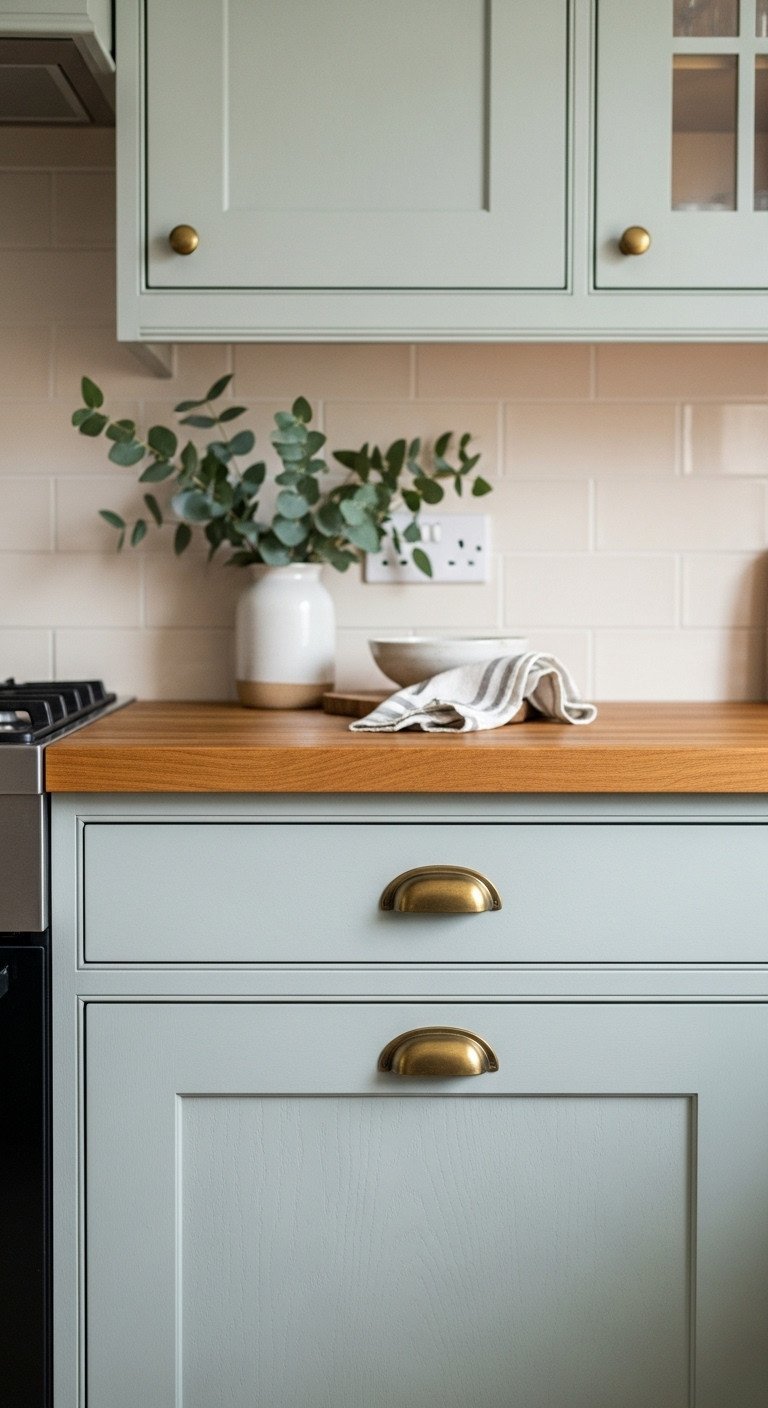
Pin this serene kitchen look to your ‘Home Inspiration’ board!
Sage green shaker cabinets are the cornerstone of a timeless green kitchen. This soft, muted green feels calming and sophisticated, pairing beautifully with the warmth of natural materials. The simple lines of Shaker-style cabinets provide a perfect canvas for the color, while warm butcher block countertops and aged brass cabinet hardware complete the classic, cozy aesthetic. This combination feels both fresh and deeply rooted in tradition.
Materials Needed:
- High-quality cabinet paint in a sage green color (satin or matte finish)
- Liquid deglosser and sandpaper (120 and 220 grit)
- High-adhesion primer
- Solid brass cabinet pulls or knobs
- Butcher block countertop section, conditioned with food-safe mineral oil
- Cream-colored ceramic subway tiles and white grout
Step-by-Step Directions:
- Prep Cabinets: Remove cabinet doors and hardware. Thoroughly clean all surfaces with a TSP cleaner, then use a liquid deglosser to remove the old finish.
- Sand & Prime: Lightly sand all surfaces with 120-grit sandpaper, wipe clean, and apply one coat of high-adhesion primer. Once dry, lightly sand with 220-grit for a smooth finish.
- Paint: Apply two thin coats of the sage green cabinet paint, allowing ample drying time between coats as per the manufacturer’s instructions. A small roller for flat surfaces and a quality brush for details works best.
- Install Countertop & Hardware: Once paint is fully cured (usually 3-5 days), re-hang doors and install the new brass hardware. Secure the butcher block countertop according to instructions, ensuring it’s properly sealed.
- Add Backsplash: Install the cream subway tile backsplash, grout, and seal to complete the look.
Pro-Tip: Don’t skip the prep work! Proper cleaning, deglossing, and priming is 90% of the work and the absolute key to a durable, professional-looking paint finish on your cabinets.
2. Create a Dramatic Focal Point with a Forest Green Island

Save this bold kitchen island idea for your dream reno!
If you love the idea of a dark green rustic kitchen but are hesitant to commit to a full wall of color, a statement kitchen island is the perfect solution. Painting just the island a deep, moody forest green creates a dramatic kitchen focal point without overwhelming the space. Topped with a thick slab of reclaimed wood, the island becomes a stunning centerpiece that grounds the room. This modern rustic kitchen approach feels bold, sophisticated, and deeply connected to nature.
Materials Needed:
- High-quality cabinet or furniture paint in a deep forest green
- A kitchen island base (new or existing)
- A thick slab of reclaimed wood or a pre-made butcher block top
- Matte black cabinet pulls or knobs
- Wood stain (optional, to match other wood tones) and food-safe wood sealant
- Sandpaper and primer
Step-by-Step Directions:
- Prepare the Island Base: If using an existing island, clean, sand, and prime the base. If building a new one, assemble it according to the plans.
- Paint the Base: Apply two coats of the forest green paint to the island base, allowing for proper drying time.
- Prepare the Top: Cut the reclaimed wood or butcher block to size, with a 1-1.5 inch overhang on each side. Sand it smooth, starting with a lower grit and finishing with a fine grit.
- Finish the Top: If desired, apply a wood stain to match other elements in your kitchen. Once dry, apply multiple coats of a durable, food-safe sealant, lightly sanding between coats for a professional finish.
- Assemble: Attach the finished wood top to the painted island base and install your matte black hardware.
Lesson Learned: When using a dark, bold color like forest green on an island, keep the perimeter cabinets and walls a lighter, neutral color (like a warm white or light gray) to maintain balance and prevent the room from feeling too dark.
3. Add Warmth and Character with Reclaimed Wood Open Shelving
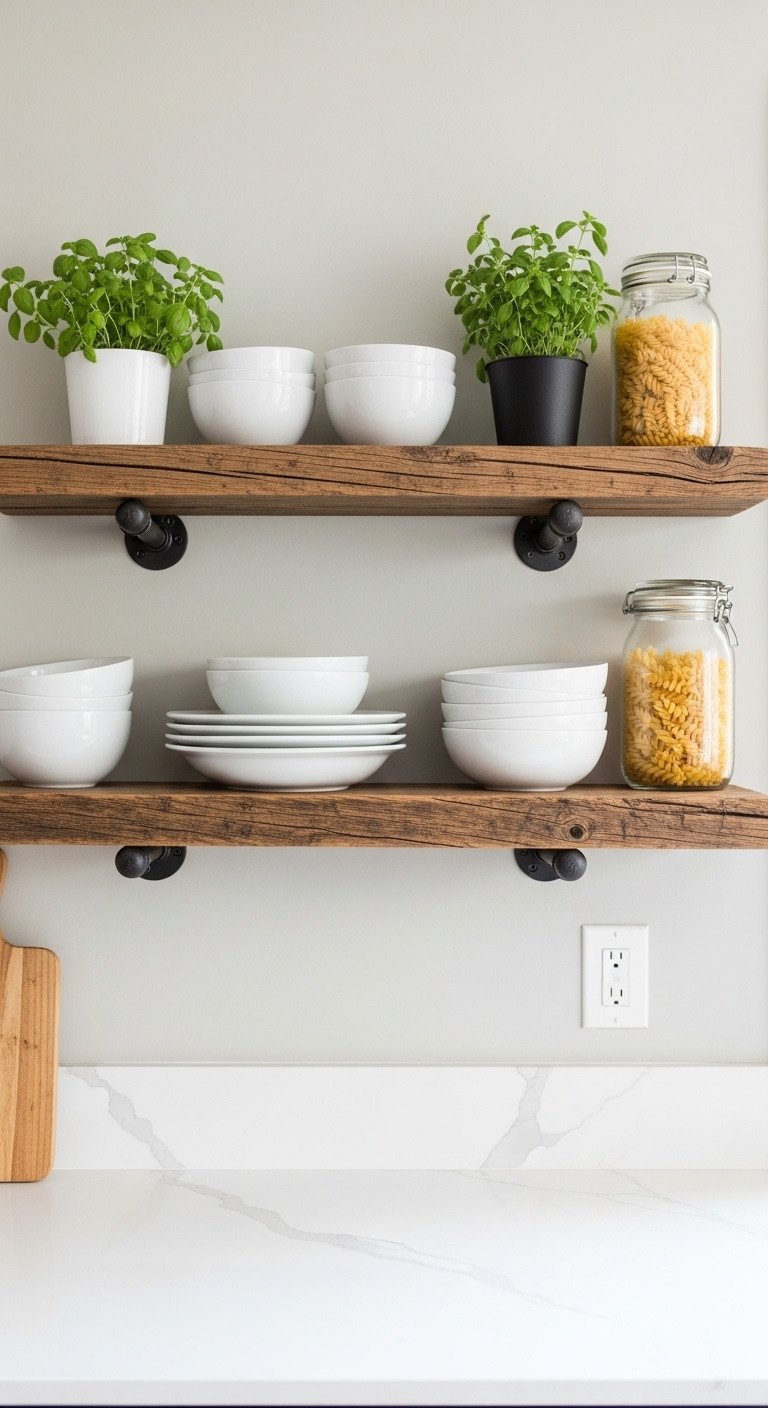
Pin this simple DIY shelving idea for instant rustic charm!
Nothing says “rustic” quite like the authentic texture and history of reclaimed wood. Replacing a section of upper cabinets with thick, reclaimed wood open shelving is an easy DIY project that instantly injects warmth and character. Supported by black industrial pipe shelf brackets, these shelves provide a perfect spot to display everyday white dishes, glassware, and small potted herbs, adding a layer of practical beauty to your kitchen.
Materials Needed:
- Reclaimed wood planks (2-inches thick is ideal)
- Heavy-duty industrial pipe shelf brackets and matching screws
- A stud finder, level, and drill
- Sandpaper (medium and fine grit)
- Natural wax or matte polyurethane finish
Step-by-Step Directions:
- Source and Prep the Wood: Find reclaimed wood from a lumber yard or architectural salvage. Cut the planks to your desired length and sand them smooth, being careful to retain their rustic character.
- Finish the Shelves: Wipe the shelves clean and apply a natural wax or a matte polyurethane finish to protect the wood from moisture without making it look glossy.
- Locate Studs: Use a stud finder to locate the wall studs where you plan to hang your shelves. This is critical for ensuring they can support the weight of dishes. Mark the locations lightly with a pencil.
- Install Brackets: Using a level to ensure they are straight, drill pilot holes and securely attach the pipe brackets to the wall studs with heavy-duty screws.
- Mount Shelves: Place your finished wood planks onto the brackets and secure them from underneath if the bracket design allows. Style with your favorite everyday dishes, glassware, and a touch of greenery.
Pro-Tip: When styling open shelves, stick to a simple color palette (like all-white dishes) to avoid a cluttered look. Mix in natural elements like small plants, wood cutting boards, and glass jars for texture and warmth.
4. Add Cottage Appeal with a Painted Beadboard Backsplash
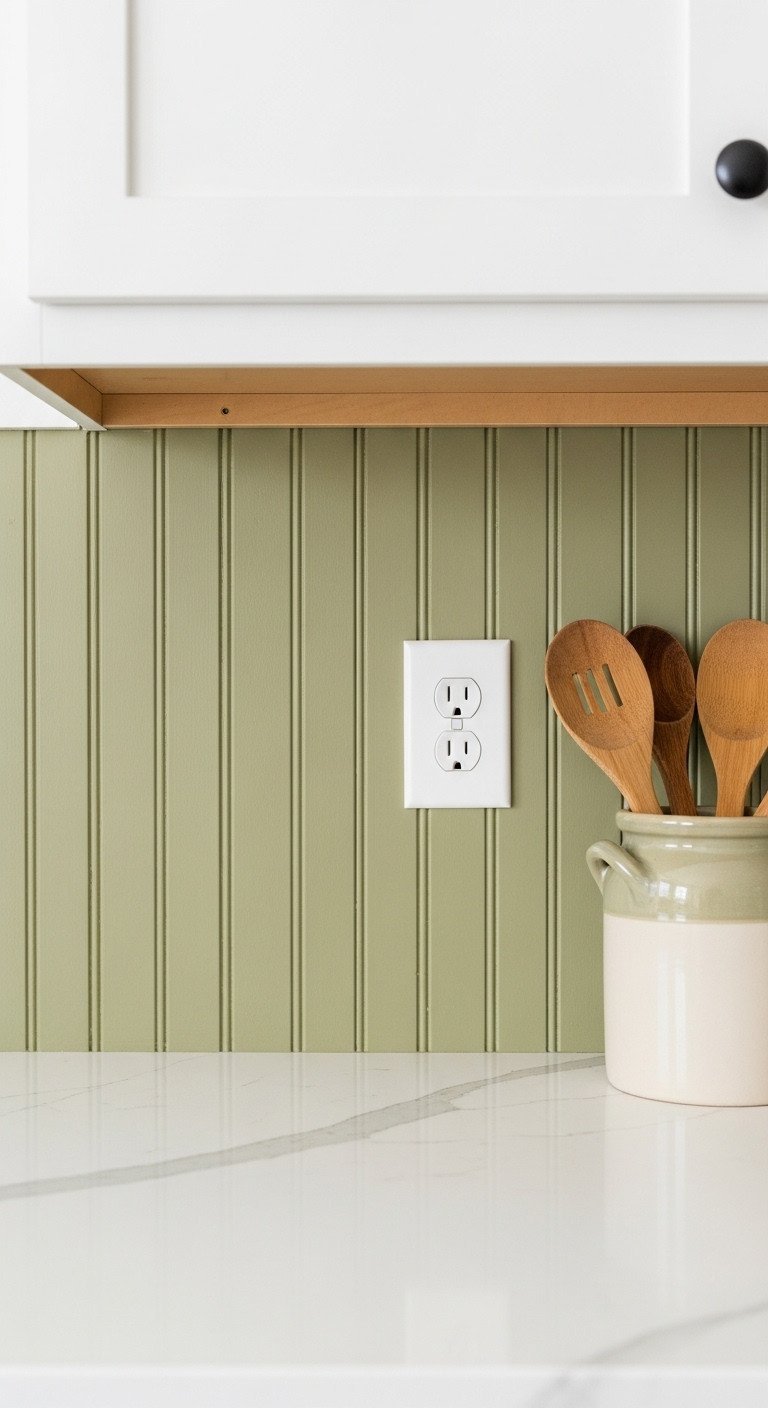
Save this budget-friendly backsplash idea for a touch of cottage charm!
For a touch of cottage kitchen charm, a beadboard backsplash is a budget-friendly and DIY-friendly alternative to tile. Painted in a soft, muted olive green, a beadboard backsplash adds subtle texture and a layer of vintage character. This is an excellent option for a rustic kitchen on a budget, as it’s inexpensive and relatively easy to install, yet it delivers a high-impact design statement that perfectly complements the rustic aesthetic.
Materials Needed:
- Sheets of beadboard paneling (moisture-resistant is best for kitchens)
- A tape measure, level, and jigsaw or circular saw
- Construction adhesive and a caulk gun
- Brad nailer (optional, but recommended)
- Spackling or wood filler
- High-quality, scrubbable paint in a muted olive green (semi-gloss finish is ideal for cleaning)
- Paintable caulk
Step-by-Step Directions:
- Measure and Cut: Carefully measure the backsplash area, marking out any necessary cuts for outlets or switches. Use a jigsaw to cut the beadboard panels to size.
- Dry Fit: Hold the cut panels in place to ensure a perfect fit before applying any adhesive.
- Install Panels: Apply a generous amount of construction adhesive to the back of the panels in a zigzag pattern. Press the panel firmly against the wall. Use a brad nailer to add a few nails along the top and bottom for extra security.
- Finish Seams: Fill any nail holes or seams between panels with a small amount of spackling. Once dry, sand it smooth.
- Caulk and Paint: Apply a bead of paintable caulk along the bottom where the beadboard meets the countertop and along the top where it meets the cabinets. Once the caulk is dry, apply two coats of your olive green paint.
Pro-Tip: For the area directly behind the stove, consider adding a small, easy-to-clean panel of stainless steel or quartz over the beadboard to protect it from heat and grease splatters.
5. Go All-In on Rustic with Faux-Wood Beams
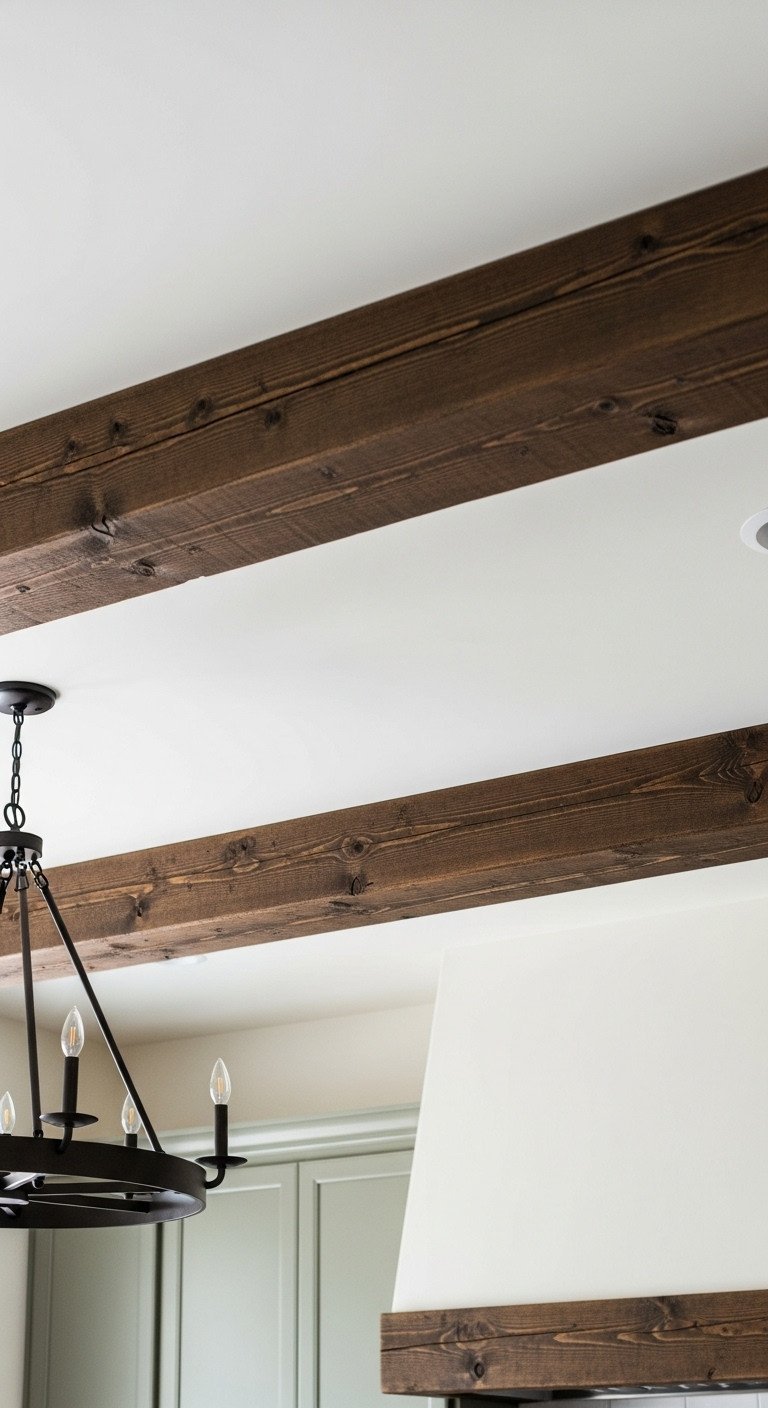
Save this idea to add major architectural character to your kitchen!
To achieve a truly authentic rustic look, take your design to the next level—the ceiling. Installing faux wood ceiling beams adds immediate architectural character and warmth to any kitchen. These lightweight beams provide the visual impact of heavy, exposed wood beams without the structural challenges and high cost. Placed on a high, white ceiling above your muted green cabinets, they draw the eye upward and create a sense of grandeur and history.
Materials Needed:
- Lightweight faux-wood beams (made from high-density polyurethane)
- Measuring tape and chalk line
- 2×4 lumber for creating mounting blocks
- Stud finder and drill
- Construction adhesive
- Screws long enough to go through the mounting blocks and into the ceiling joists
- Matching wood stain for touch-ups
Step-by-Step Directions:
- Plan the Layout: Decide on the placement and spacing of your beams. Use a chalk line to snap straight guidelines on the ceiling.
- Locate Joists: Use a stud finder to locate the ceiling joists along your chalk lines. Mark their positions.
- Install Mounting Blocks: Cut 2×4 lumber into blocks that will fit snugly inside the hollow of your faux beams. Screw these mounting blocks into the ceiling joists at each marked location.
- Cut and Test Fit Beams: Carefully measure and cut the faux beams to length using a hand saw or circular saw. Lift a beam into place over the mounting blocks to ensure a snug fit.
- Secure the Beams: Apply a liberal amount of construction adhesive to the top edges of the faux beam and to the faces of the mounting blocks. Hoist the beam into place and screw through the sides of the beam directly into the mounting blocks to secure it.
- Touch-Up: Use the matching stain to touch up any visible screw heads or cut ends for a seamless finish.
Lesson Learned: Faux beams are incredibly convincing and much lighter and easier to install than real wood. Always buy them slightly longer than you need so you can make precise cuts for a perfect fit against the walls.
6. Anchor the Space with a Timeless Apron-Front Sink
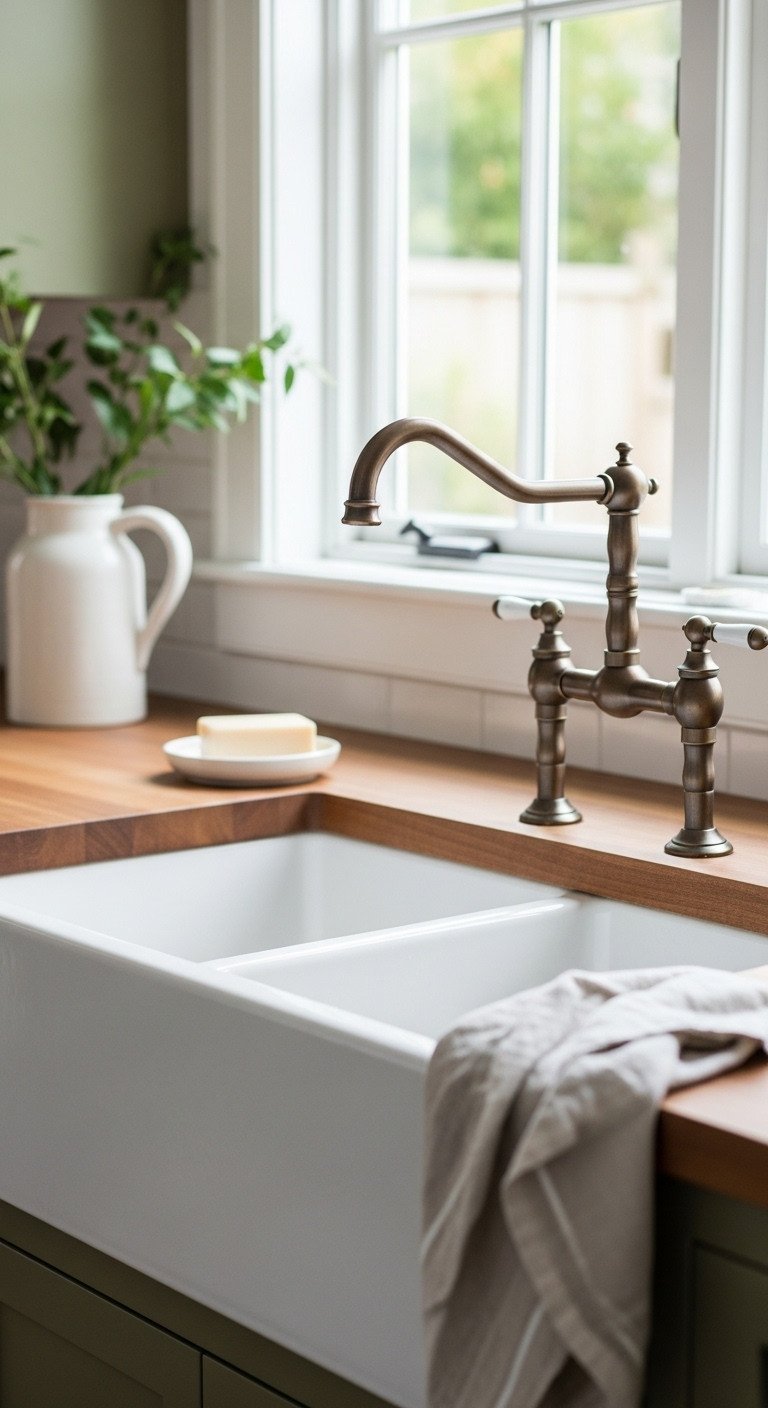
Pin this classic sink that defines the modern farmhouse look!
The apron-front sink, often called a farmhouse sink, is an iconic element that instantly anchors a rustic kitchen. A large, white fireclay sink creates a functional and beautiful centerpiece, especially when set into a warm wood countertop. Its exposed front adds a touch of vintage charm and substance. Paired with a vintage-inspired bridge kitchen faucet in an oil-rubbed bronze finish, this classic rustic kitchen sink becomes a hardworking hero of the space.
Materials Needed:
- A fireclay or cast iron apron-front sink (ensure you have the correct size for your cabinet base)
- A specialized sink base cabinet designed for apron-front sinks
- A bridge-style or gooseneck faucet in an aged finish like oil-rubbed bronze
- Plumber’s putty and silicone sealant
- Standard plumbing supplies (P-trap, drain lines, etc.)
Step-by-Step Directions:
- Install the Base Cabinet: An apron-front sink requires a special base cabinet where the front is cut lower to expose the sink front. Install this cabinet first, ensuring it is perfectly level.
- Build Support (if needed): These sinks are extremely heavy. Build a support frame inside the cabinet using 2x4s for the sink to rest on, ensuring the top of the sink will be flush with the top of the countertops.
- Set the Sink: Carefully lower the sink onto the support frame. Check that it is level from front-to-back and side-to-side.
- Install Countertops: The countertop installers will template and cut the countertop to fit perfectly around the sink. They will typically install this for you.
- Install Faucet and Plumbing: Install the faucet into the pre-drilled holes in the countertop or sink deck. Connect the drain and water supply lines. Seal the small gap between the sink and the countertop with a thin bead of silicone sealant.
Pro-Tip: Before you buy the sink, double-check the specifications for the required base cabinet size. This is not a standard cabinet, and getting the measurements right from the start is crucial for a successful installation.
7. Set the Mood with Warm, Vintage-Style Pendant Lighting
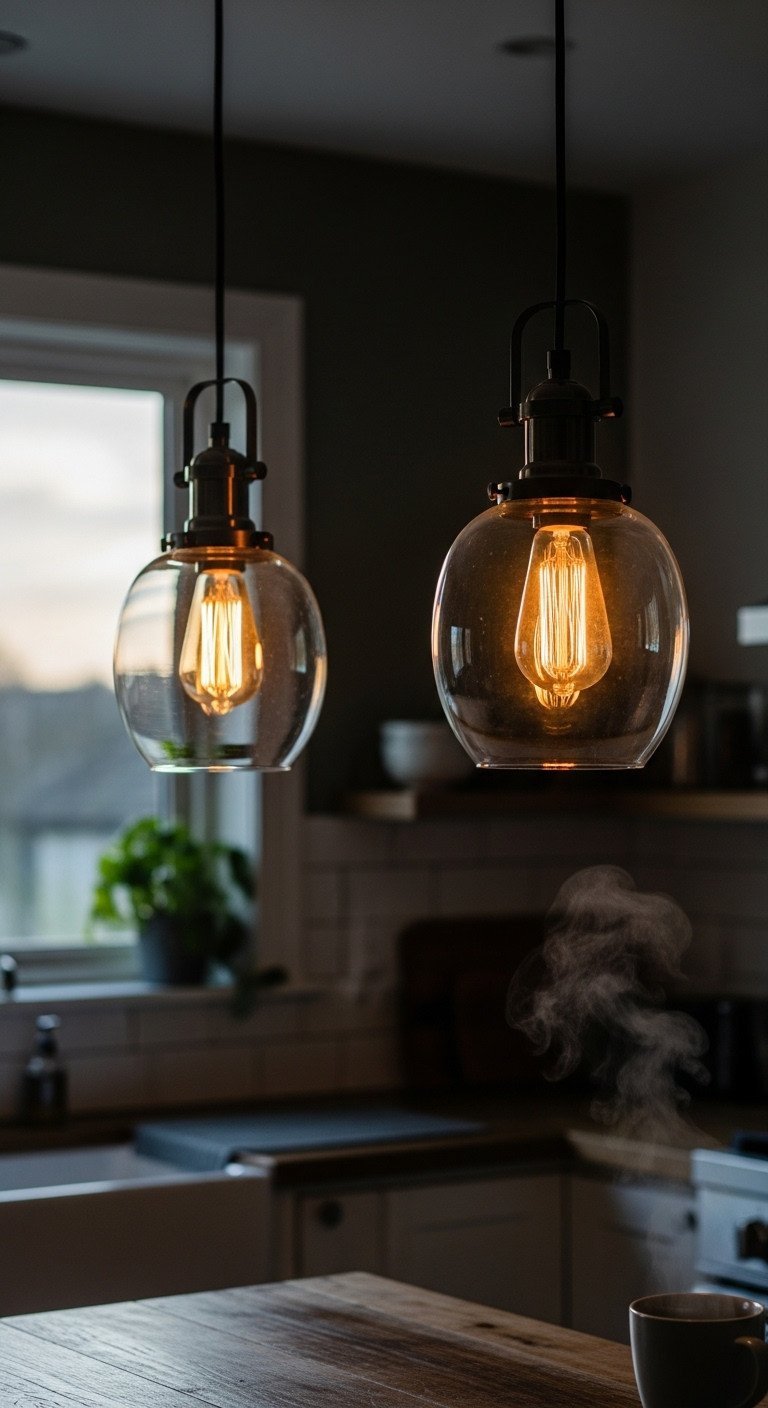
Save this lighting idea to add the perfect warm glow to your kitchen!
Lighting is essential for creating the cozy, inviting atmosphere of a rustic kitchen. Vintage kitchen lights, especially rustic pendant lighting with clear glass shades and dark bronze metal, are the perfect choice. Hung in a pair or trio over a kitchen island, these fixtures, fitted with warm-glow Edison bulbs, provide both functional task lighting and a beautiful ambient mood. They act as jewelry for the room, completing the farmhouse lighting aesthetic.
Tools & Materials Needed:
- 2-3 vintage-style pendant lights
- Dimmable LED Edison-style bulbs
- A non-contact voltage tester
- Wire strippers, wire nuts, and electrical tape
- A ladder and a screwdriver
- (Optional) A dimmer switch
Step-by-Step Directions:
- Safety First: Turn off the power to the kitchen light circuit at your home’s breaker box. Use the voltage tester to confirm there is no power at the existing fixture’s electrical box.
- Remove Old Fixture: Carefully remove the old light fixture, disconnecting the wires (usually black, white, and copper/green).
- Install Mounting Bracket: Attach the new pendant light’s mounting bracket to the electrical box in the ceiling.
- Adjust Height: Adjust the cord or chain of the pendant so it hangs at the correct height. A general rule is 30-36 inches above the countertop. Ensure all pendants are at the exact same height.
- Connect Wires: Have a helper hold the fixture while you connect the wires: black to black (hot), white to white (neutral), and the bare copper/green to the grounding screw. Secure each connection with a wire nut and a wrap of electrical tape.
- Attach Fixture and Restore Power: Tuck the wires into the electrical box and secure the new fixture’s canopy to the mounting bracket. Install the Edison bulbs, turn the power back on, and test your new light.
Pro-Tip: Install a dimmer switch for your pendant lights. This allows you to have bright task lighting when you’re working at the island and a soft, ambient glow for a cozy atmosphere in the evenings.
8. Balance the Look with Modern Soapstone-Look Countertops
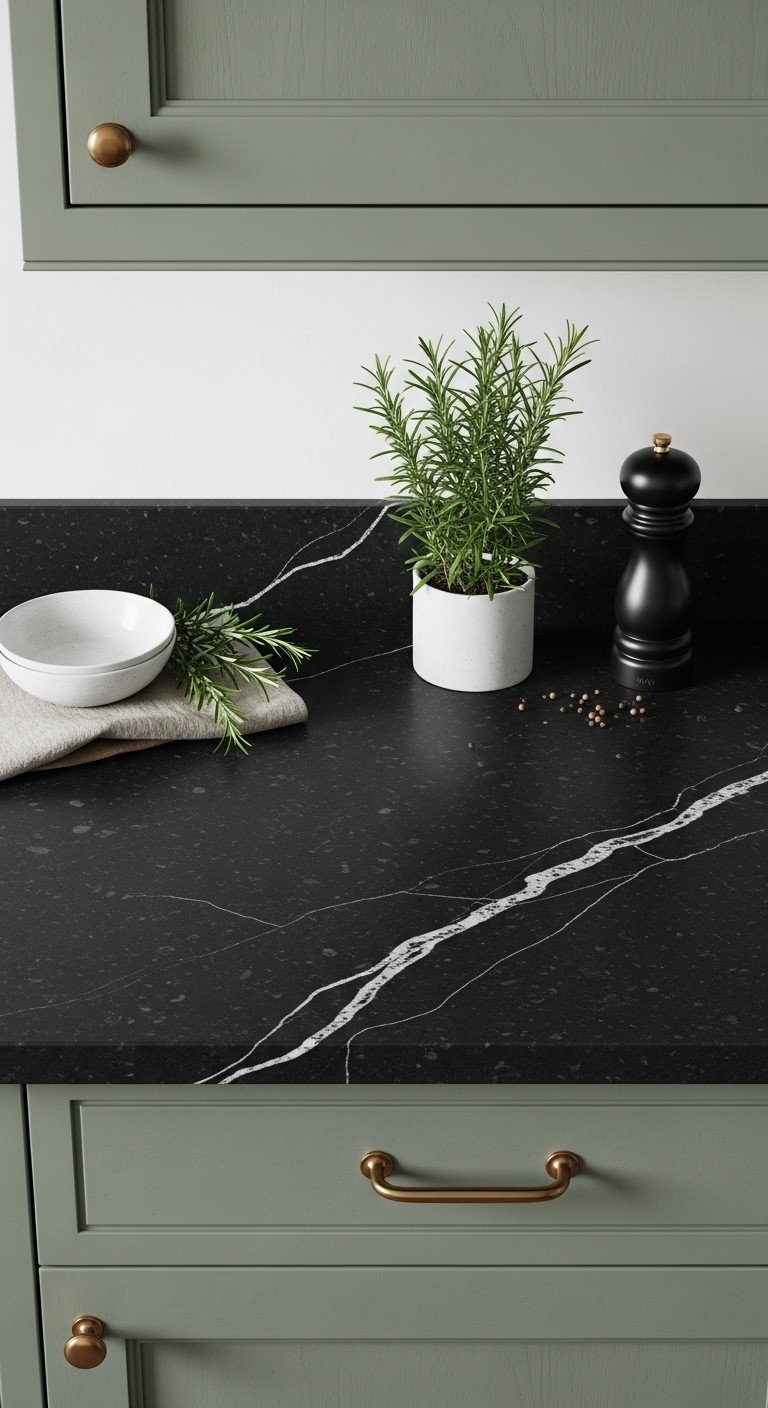
Pin this durable and stylish countertop idea for a modern rustic vibe!
To create a sophisticated modern rustic kitchen, balance the warmth of green cabinets with sleek, dark kitchen countertops. A soapstone-look quartz with a matte black finish and subtle white veining offers the perfect contrast. This choice provides the dark, moody aesthetic of natural soapstone but with the superior durability and low-maintenance benefits of quartz. It’s the ideal countertop to pair with green cabinets when you want a look that feels both rustic and contemporary.
Resources Needed:
- Consultation with a local countertop fabricator
- Samples of different soapstone-look quartz from brands like Caesarstone, Silestone, or Cambria
- A clear plan of your kitchen layout, including sink and cooktop cutouts
- A professional installation team (this is not a DIY job)
Step-by-Step Directions:
- Get Samples: Visit local stone yards or kitchen showrooms to get physical samples of soapstone-look quartz. Take them home to see how they look next to your cabinet color in your kitchen’s natural light.
- Choose a Fabricator: Select a reputable countertop fabricator and installer. They will be responsible for measuring, cutting, and installing the slab. Get quotes from at least three different companies.
- Templating: The installer will visit your home to create a precise template of your countertops. Your cabinets must be fully installed and level before this can happen. This is when you will confirm details like edge profiles and sink type (undermount is standard).
- Fabrication: The fabricator will use the template to cut your quartz slab to size at their workshop, creating holes for the sink, faucet, and cooktop.
- Installation: The professional team will deliver and install the finished countertops, securing them to the cabinets and creating any necessary seams. An undermount sink will also be installed at this time.
Lesson Learned: While real soapstone is beautiful, it’s a softer stone that can scratch and requires regular oiling. Soapstone-look quartz gives you the same dark, moody, and matte aesthetic but with superior durability and zero maintenance, making it a perfect choice for busy family kitchens.
9. Ground the Room with an Earthy, Textured Tile Floor
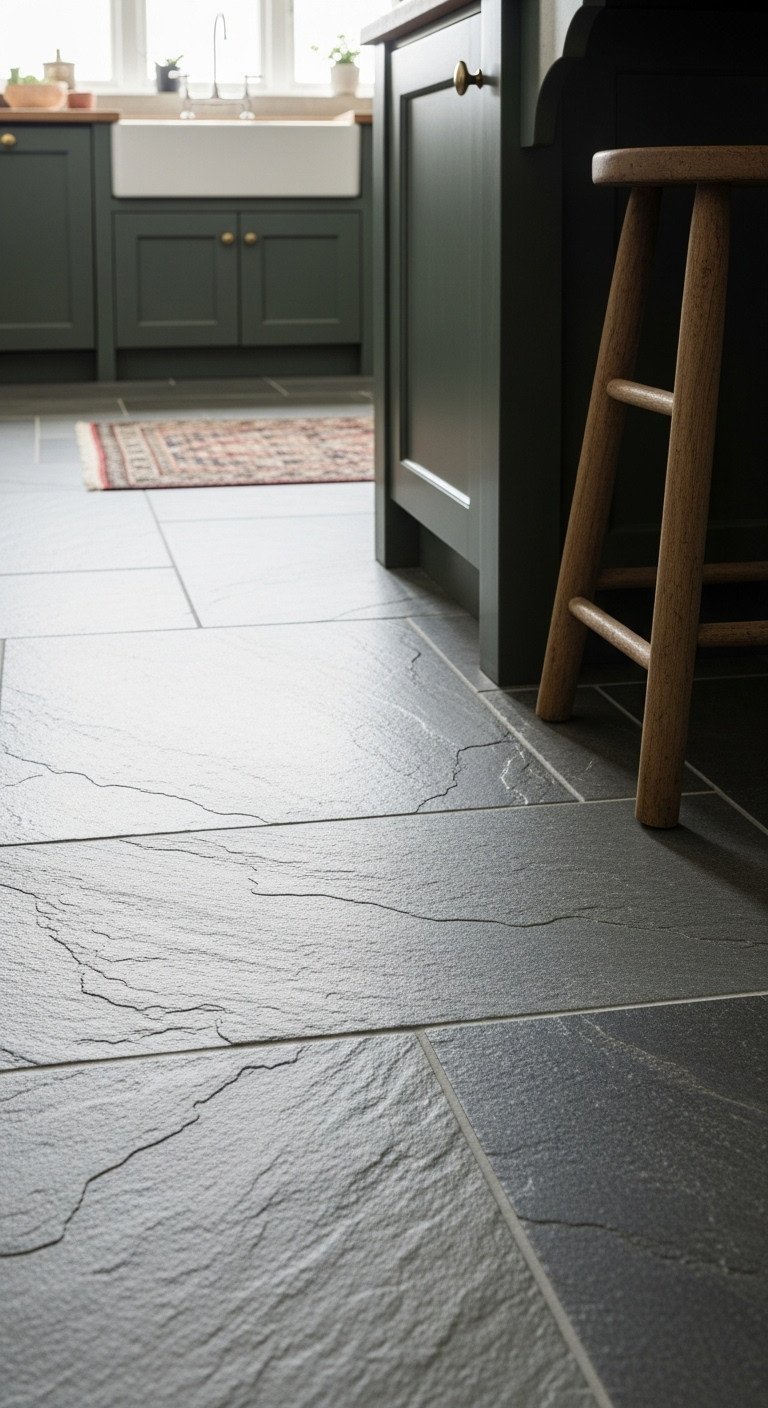
Save this durable and beautiful flooring idea for your rustic kitchen!
The right rustic kitchen flooring provides a durable and earthy foundation for the entire design. A textured, slate-look porcelain tile in varying shades of charcoal and gray is an excellent choice. This material offers the natural, riven texture of real stone but with the superior durability and ease of maintenance of porcelain, making it perfect for a high-traffic kitchen. This flooring option grounds the green cabinetry and wood tones, completing the natural, organic feel of the space.
Materials Needed:
- Slate-look porcelain tiles
- A stable, clean subfloor
- Thin-set mortar and a notched trowel
- A tile saw or tile cutter
- Tile spacers
- Dark gray or charcoal-colored grout
- A grout float, sponges, and buckets
Step-by-Step Directions:
- Prepare the Subfloor: Ensure your subfloor is perfectly clean, level, and free of any debris. Address any cracks or unevenness before you begin.
- Plan Your Layout: Find the center of the room and snap chalk lines to create a grid. Do a ‘dry lay’ of some tiles to check your pattern and minimize awkward cuts.
- Apply Mortar and Set Tiles: Working in small sections, spread the thin-set mortar with the notched trowel. Firmly press each tile into the mortar with a slight twisting motion. Use tile spacers to ensure consistent grout lines.
- Make Cuts: Use a tile saw to make any necessary cuts around walls, cabinets, or obstacles.
- Grout the Floor: After the mortar has fully cured (typically 24-48 hours), remove the spacers. Mix the grout and apply it with a grout float, pressing it into the joints at a 45-degree angle.
- Clean and Seal: Use a damp sponge to wipe the excess grout off the tile surfaces, rinsing the sponge frequently. After the grout has cured (check manufacturer’s instructions), apply a grout sealer to protect it from stains.
Pro-Tip: Choose a grout color that is similar to or slightly darker than the main color of the tile. A dark gray or charcoal grout will hide dirt better than a light grout and will enhance the natural stone look of the tile.
Key Takeaways: Your Quick Guide to a Green Rustic Kitchen
- Choose Your Green Wisely: Lighter greens like sage make small spaces feel bigger, while darker greens like forest create a cozy, dramatic focal point.
- Embrace Natural Texture: The “rustic” element comes from texture. Incorporate wood (cabinets, countertops, shelves), stone, and natural fibers to add warmth and character.
- Balance is Everything: Pair bold or dark green elements with lighter neutrals on walls, backsplashes, or countertops to prevent the room from feeling too heavy.
- Lighting is Key: A layered lighting plan with ambient, task, and accent lights (especially warm pendants) is crucial for creating a cozy, functional atmosphere.
- Hardware Matters: The “jewelry” of the kitchen, hardware in warm metals like brass or classic matte black, completes the look and ties all the elements together.
People Also Ask About Green Rustic Kitchens
Is a green kitchen a timeless choice or just a trend?
Earthy, nature-inspired greens are a timeless choice in interior design because they connect our homes to the outdoors. While a specific shade like avocado green might become dated, classic hues like sage, olive, and forest green act as versatile near-neutrals that pair beautifully with timeless materials like wood and stone, ensuring your kitchen remains stylish for years to come.
What color countertops go best with green rustic cabinets?
For a classic warm and rustic look, butcher block countertops are the perfect choice. For a brighter feel, consider creamy white or light beige quartz. To create a modern, high-contrast design, pair your green cabinets with dark, matte countertops like black soapstone or soapstone-look quartz for a sophisticated finish.
How do you make a rustic kitchen look modern?
To create a “modern rustic” look, blend rustic textures with clean lines and modern finishes. Pair distressed wood elements with sleek, dark quartz countertops. Use simple, unadorned cabinet styles like flat-panel or shaker, and choose minimalist hardware in a modern finish like matte black. Keeping the overall layout open and clutter-free is also key.
What flooring works best in a green rustic kitchen?
Natural hardwood flooring is the quintessential choice for a green rustic kitchen, as it enhances the warmth and organic feel. Other excellent, durable options include natural stone like slate or travertine, or a high-quality wood-look or stone-look porcelain tile, which offers the rustic aesthetic with superior durability and ease of maintenance.
FAQs About Green Rustic Kitchen
Can you have a green rustic kitchen in a small space?
Yes, absolutely. For a smaller kitchen, opt for a lighter shade of green, such as sage or mint, to help the space feel more open and airy. Another great strategy is to use green paint on the lower cabinets only, with white or a very light neutral on the upper cabinets to draw the eye upward and make the room feel taller.
What wall color should I use with green cabinets?
A warm, soft white or a creamy off-white is a beautiful and safe choice. This allows the green cabinets to be the main feature without competition. For a cozier, more dramatic look, you could use a complementary dark color on an accent wall or even a textured finish like plaster.
How do you add rustic elements without a full renovation?
You can easily add rustic charm with smaller updates. Consider installing reclaimed wood open shelving, changing out your cabinet hardware for aged brass or matte black pulls, adding a vintage-style woven rug, or hanging a rustic pendant light over the sink or island. These small touches can make a big impact.
Are wood countertops hard to maintain?
Wood countertops like butcher block require more care than stone. They need to be regularly sealed with a food-safe mineral oil to prevent them from drying out, staining, or absorbing bacteria. While it’s more work, many people find the warmth and character they provide to be well worth the effort.
Is it okay to mix metals in a rustic kitchen?
Yes, mixing metals is a popular technique in rustic design. It adds character and creates a more collected, less “store-bought” feel. A good guideline is to stick to two or three metal finishes. For instance, you could use aged brass on your cabinet hardware and matte black for your lighting fixtures and faucet.
Final Thoughts
Ready to create your own natural retreat? The beauty of the green rustic kitchen is its flexibility—it can be as simple as a new coat of paint or as grand as a full renovation. It’s about choosing the elements that speak to you and crafting a space that feels like home. By balancing the calming psychology of green with the warm, natural textures of wood and stone, you can design a kitchen that is not just a place to cook, but a true sanctuary from the outside world.
Which of these ideas was your favorite? Let us know in the comments below
Last update on 2025-12-16 at 05:57 / Affiliate links / Images from Amazon Product Advertising API
